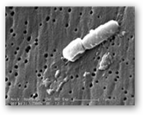The infection began with a patient that was transferred from a New York hospital that had a history of drug resistant infections  and the infection was linked to three other patients as it spread, even though in an isolation area. The NIH hospital of course is the model for which other hospitals in the US and world for that matter. Klebsiella bacteria are a leading cause of infection and can spread through ventilators, catheters and in this case it was found that the bacteria was spread even from sink drains and plumbers took out and replaced the drain pipes. This is pretty scary in essence to think that plumbing even had to be replaced to get rid of the bacteria.
and the infection was linked to three other patients as it spread, even though in an isolation area. The NIH hospital of course is the model for which other hospitals in the US and world for that matter. Klebsiella bacteria are a leading cause of infection and can spread through ventilators, catheters and in this case it was found that the bacteria was spread even from sink drains and plumbers took out and replaced the drain pipes. This is pretty scary in essence to think that plumbing even had to be replaced to get rid of the bacteria.
Part of the hospital was sectioned off and strict hand washing policies and other policies were established. To identify the strain, a study with sequencing the strains was performed on 18 samples and this allowed the hospital to follow the route of the infections and determine which patients have the infections upon arrival and which patients end up with the infection with being acquired at the facility. A total of 11 patients died from the bacteria and six survived. Researchers were also able to tell which patients actually died from the bacteria and which died from other complications combined with the bacterial infection. Six patients died from the infection itself and this is amazing that sequencing allowed the identification of the bacteria’s footprint.
This case is even scarier than MRSA in the fact that if Colistin doesn’t work which is the last straw to use with such infections, there’s nothing left to treat patients with. The rooms were even blasted by a robot with vapors of Hydrogen peroxide. If you have not see how this works, the link below has a video that shows how a robot works to disinfect the patient rooms. The bacteria is evidently pretty resistant as it was found on a ventilator that had been bleached twice.
Hospital Robot Blasts Bacteria With One UV Swoop to Disinfect Rooms And All the Contents
In essence, one item here somewhat states that in addition to normal bacteria fighting policies, will DNA sequencing become part of the future at hospitals to identify and track such infections? With this strain of bacteria it certainly sounds like it and where will the money come from? Hospitals with  a few exceptions across the US are cash strapped and after reading this even someone who is not in healthcare can appreciate the efforts of the investigation and as with all research it will improve and get better. Also, how about nursing homes which are also known to have issued with bacterial infections. Every patient now is screened at the NIH facility who is transferred from another facility for super bugs and now this one should be on the list for mandated reports too with CDC.
a few exceptions across the US are cash strapped and after reading this even someone who is not in healthcare can appreciate the efforts of the investigation and as with all research it will improve and get better. Also, how about nursing homes which are also known to have issued with bacterial infections. Every patient now is screened at the NIH facility who is transferred from another facility for super bugs and now this one should be on the list for mandated reports too with CDC.
Again, this is a stop and think for reporting and responding to hospital acquired infections, especially with this case of having to literally rip out plumbing to eradicate it and it could happen anywhere. The New York hospital that transferred the patient who brought the infection to the facility was not identified but you can bet after this information and research was made available that they too did a vigorous investigation to ensure that it was no longer living there as well. BD
Researchers unraveled a medical mystery that left six patients dead last year at the National Institutes of Health's elite research hospital, demonstrating that gene sequencing can help in the fight against hospital-acquired infections.
The NIH researchers' sleuth work—they stalked a deadly strain of antibiotic-resistant Klebsiella pneumonia through 18 patients at the agency's 243-bed Clinical Center in Bethesda, Md.—was detailed in a study published online Wednesday by Science Translational Medicine. The scientists sequenced the genes of the microbial invader to reveal its exact path from patient to patient until the deadly outbreak was contained in December.
The outbreak began on June 13, 2011, when a 43-year-old female patient with a history of multiple drug-resistant infections was transferred from a New York City hospital. Although the patient was admitted into an isolation area, the Klebsiella colony she had brought with her into the hospital soon leapt to at least three other patients. The NIH did not identify the New York hospital.
At the NIH's Clinical Center, researchers began sequencing the bacteria specimens in mid-August after three patients displayed symptoms. They determined that the third patient to become infected had actually acquired the bacteria from the original New York patient while both were being treated in the ICU, before passing it on to the second patient who showed symptoms.
The researchers determined that the bug was also spreading from sink drains, based on the genetic trail, possibly by splashing upward as people washed their hands. "We didn't test this possibility—we just had the plumbers take out the drain pipes," Dr. Segre said in an email.
http://online.wsj.com/article/SB10000872396390444812704577605473262312862.html



In this world if anything that can clearly distinguish you from others or proves your identity is nothing but DNA testing, so whether it is in case of forensic lab requirement or anything research it becomes really important. Thanksssss……
ReplyDelete